litos工程添加自定义demo_liteos增加自定义的系统调用-程序员宅基地
Litos
这篇文章主要描述我们如何在litos工程中,自定义一个demo出来。
文章目录
前言
1.环境及MCU 小熊派(IOT开发板)+linux环境+litos
提示:以下是本篇文章正文内容,下面案例可供参考
一、前期准备
1.如果你想完成自定义demo,首先你需要去看一下其它demo中是如何定义这个demo的。比如说Kconfig,makefile,需要什么文件等等。
2.你需要对makefile,Kconfig这种文件语法懂一些。
3.自己要会编译下载。(不会的话,参考我的一篇环境搭建的文章,里面包含了如何下载程序)
二、使用步骤
1.查看其它demos文件
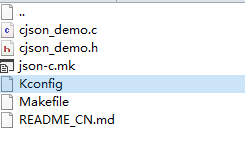
- 建议你用source insight建立一个工程,查看方便。
- 上述图片是我写好的调用cjson库的demo,后面我就以这个讲解
- json-c.mk文件是增加一个当前的头文件路径
DEMOS_JSON_INCLUDE := \
-I $(LITEOSTOPDIR)/demos/utility/cjson
- Kconfig文件是增加一个编译选项
config LOSCFG_DEMOS_CJSON
bool "Enable cJson Demo"
default n
help
Answer y to enable json demo.
- Makefile 提供一些编译文件名,统计头文件路径称等等,可以细细看看
include $(LITEOSTOPDIR)/config.mk
include $(LITEOSTOPDIR)/demos/utility/cjson/json-c.mk
MODULE_NAME := cjson_demo
JSON_DEMO_SRCS = $(wildcard *.c)
JSON_DEMO_INCLUDE := \
-I $(LITEOSTOPDIR)/lib/libc/include \
-I $(LITEOSTOPDIR)/components/lib/cjson/$(CJSON_VERSION)\
-I $(LITEOSTOPDIR)/demos/utility/cjson
LOCAL_INCLUDE := $(JSON_DEMO_INCLUDE) $(COMPONENTS_JSON_INCLUDE)
LOCAL_SRCS := $(subst $(CURDIR)/,, $(JSON_DEMO_SRCS))
LOCAL_EXT_FLAG := -Wno-error -fstack-protector-strong
LOCAL_FLAGS := $(LOCAL_EXT_FLAG) $(LOCAL_INCLUDE)
include $(MODULE)
2.修改上层目录的Kconfig和mk
(1)找到utility目录下的Makefile
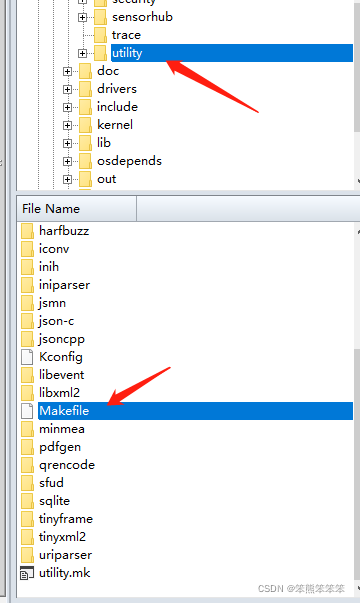
(2)Makefile添加这条数据
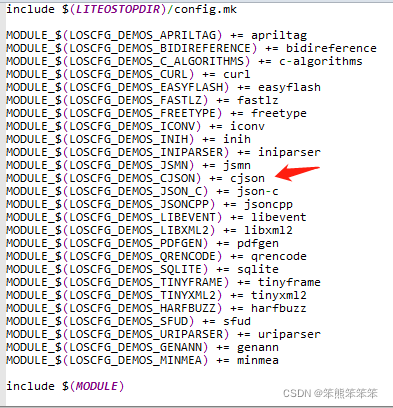
(3)同理,此目录中找到Kconfig文件,并添加如下箭头数据
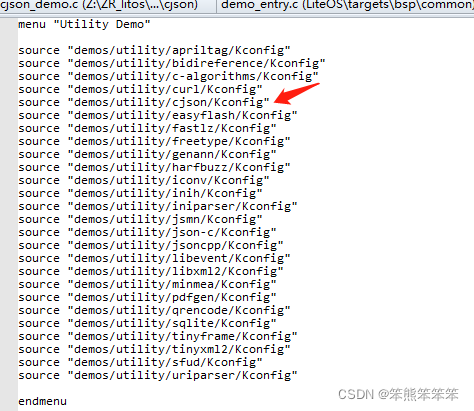
(3)找到utility.mk文件,添加如下箭头数据
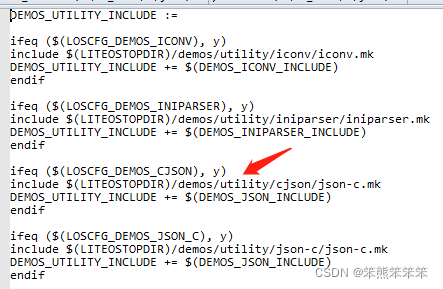
3.执行make menuconfig选择库和新加demo
(1)使能cjson库
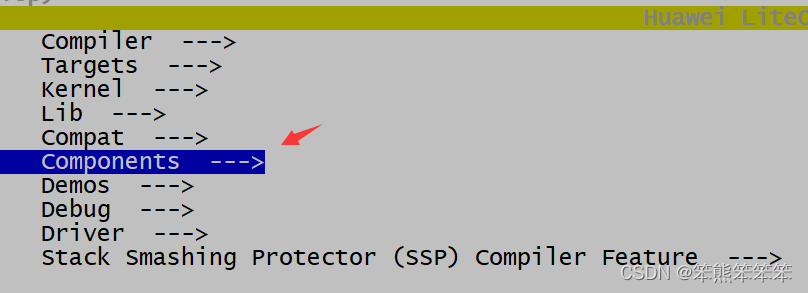
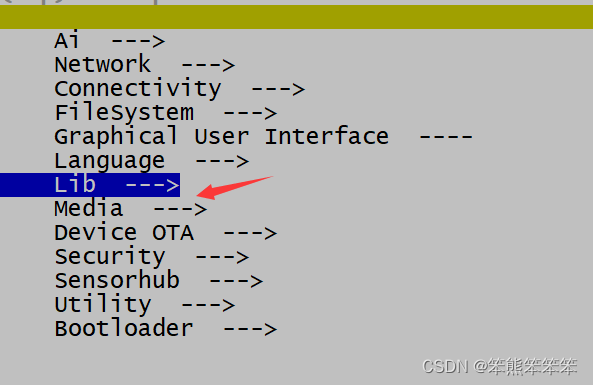
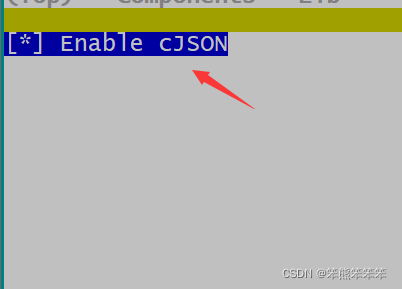
(2)使能cjson_demo

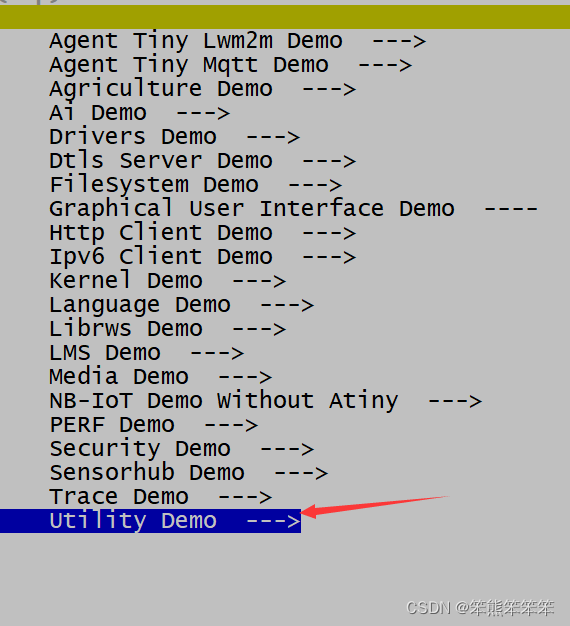
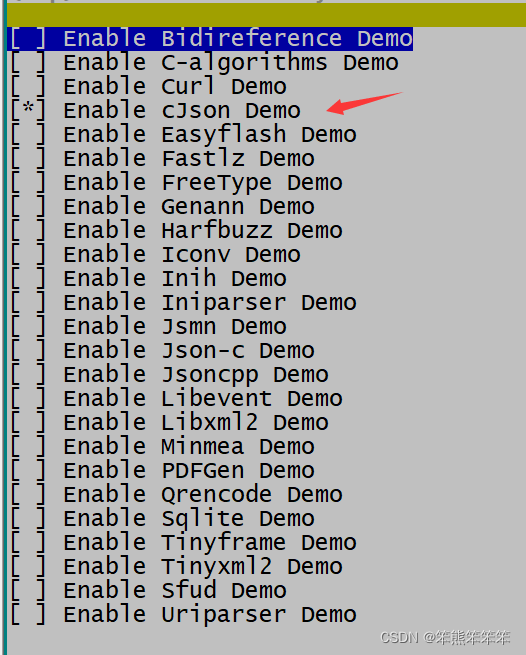
4.修改cjson_demo.c和.h文件
#include <stdio.h>
#include <stdlib.h>
#include <string.h>
#include "cJSON.h"
#include "los_task.h"
#define CJSON_TASK_PRIORITY 3
#define CJSON_TASK_STACK_SIZE 0x1000
STATIC UINT32 g_demoTaskId;
/* Used by some code below as an example datatype. */
struct record
{
const char *precision;
double lat;
double lon;
const char *address;
const char *city;
const char *state;
const char *zip;
const char *country;
};
/* Create a bunch of objects as demonstration. */
static int print_preallocated(cJSON *root)
{
/* declarations */
char *out = NULL;
char *buf = NULL;
char *buf_fail = NULL;
size_t len = 0;
size_t len_fail = 0;
/* formatted print */
out = cJSON_Print(root);
/* create buffer to succeed */
/* the extra 5 bytes are because of inaccuracies when reserving memory */
len = strlen(out) + 5;
buf = (char*)malloc(len);
if (buf == NULL)
{
printf("Failed to allocate memory.\n");
exit(1);
}
/* create buffer to fail */
len_fail = strlen(out);
buf_fail = (char*)malloc(len_fail);
if (buf_fail == NULL)
{
printf("Failed to allocate memory.\n");
exit(1);
}
/* Print to buffer */
if (!cJSON_PrintPreallocated(root, buf, (int)len, 1)) {
printf("cJSON_PrintPreallocated failed!\n");
if (strcmp(out, buf) != 0) {
printf("cJSON_PrintPreallocated not the same as cJSON_Print!\n");
printf("cJSON_Print result:\n%s\n", out);
printf("cJSON_PrintPreallocated result:\n%s\n", buf);
}
free(out);
free(buf_fail);
free(buf);
return -1;
}
/* success */
printf("%s\n", buf);
/* force it to fail */
if (cJSON_PrintPreallocated(root, buf_fail, (int)len_fail, 1)) {
printf("cJSON_PrintPreallocated failed to show error with insufficient memory!\n");
printf("cJSON_Print result:\n%s\n", out);
printf("cJSON_PrintPreallocated result:\n%s\n", buf_fail);
free(out);
free(buf_fail);
free(buf);
return -1;
}
free(out);
free(buf_fail);
free(buf);
return 0;
}
/* Create a bunch of objects as demonstration. */
static void create_objects(void)
{
/* declare a few. */
cJSON *root = NULL;
cJSON *fmt = NULL;
cJSON *img = NULL;
cJSON *thm = NULL;
cJSON *fld = NULL;
int i = 0;
/* Our "days of the week" array: */
const char *strings[7] =
{
"Sunday",
"Monday",
"Tuesday",
"Wednesday",
"Thursday",
"Friday",
"Saturday"
};
/* Our matrix: */
int numbers[3][3] =
{
{
0, -1, 0},
{
1, 0, 0},
{
0 ,0, 1}
};
/* Our "gallery" item: */
int ids[4] = {
116, 943, 234, 38793 };
/* Our array of "records": */
struct record fields[2] =
{
{
"zip",
37.7668,
-1.223959e+2,
"",
"SAN FRANCISCO",
"CA",
"94107",
"US"
},
{
"zip",
37.371991,
-1.22026e+2,
"",
"SUNNYVALE",
"CA",
"94085",
"US"
}
};
volatile double zero = 0.0;
/* Here we construct some JSON standards, from the JSON site. */
printf("Version: %s\n", cJSON_Version());
/* Our "Video" datatype: */
root = cJSON_CreateObject();
cJSON_AddItemToObject(root, "name", cJSON_CreateString("Jack (\"Bee\") Nimble"));
cJSON_AddItemToObject(root, "format", fmt = cJSON_CreateObject());
cJSON_AddStringToObject(fmt, "type", "rect");
cJSON_AddNumberToObject(fmt, "width", 1920);
cJSON_AddNumberToObject(fmt, "height", 1080);
cJSON_AddFalseToObject (fmt, "interlace");
cJSON_AddNumberToObject(fmt, "frame rate", 24);
/* Print to text */
if (print_preallocated(root) != 0) {
cJSON_Delete(root);
exit(EXIT_FAILURE);
}
cJSON_Delete(root);
printf("1333331111\n");
/* Our "days of the week" array: */
root = cJSON_CreateStringArray(strings, 7);
if (print_preallocated(root) != 0) {
cJSON_Delete(root);
exit(EXIT_FAILURE);
}
cJSON_Delete(root);
/* Our matrix: */
root = cJSON_CreateArray();
for (i = 0; i < 3; i++)
{
cJSON_AddItemToArray(root, cJSON_CreateIntArray(numbers[i], 3));
}
/* cJSON_ReplaceItemInArray(root, 1, cJSON_CreateString("Replacement")); */
if (print_preallocated(root) != 0) {
cJSON_Delete(root);
exit(EXIT_FAILURE);
}
cJSON_Delete(root);
/* Our "gallery" item: */
root = cJSON_CreateObject();
cJSON_AddItemToObject(root, "Image", img = cJSON_CreateObject());
cJSON_AddNumberToObject(img, "Width", 800);
cJSON_AddNumberToObject(img, "Height", 600);
cJSON_AddStringToObject(img, "Title", "View from 15th Floor");
cJSON_AddItemToObject(img, "Thumbnail", thm = cJSON_CreateObject());
cJSON_AddStringToObject(thm, "Url", "http:/*www.example.com/image/481989943");
cJSON_AddNumberToObject(thm, "Height", 125);
cJSON_AddStringToObject(thm, "Width", "100");
cJSON_AddItemToObject(img, "IDs", cJSON_CreateIntArray(ids, 4));
if (print_preallocated(root) != 0) {
cJSON_Delete(root);
exit(EXIT_FAILURE);
}
cJSON_Delete(root);
/* Our array of "records": */
root = cJSON_CreateArray();
for (i = 0; i < 2; i++)
{
cJSON_AddItemToArray(root, fld = cJSON_CreateObject());
cJSON_AddStringToObject(fld, "precision", fields[i].precision);
cJSON_AddNumberToObject(fld, "Latitude", fields[i].lat);
cJSON_AddNumberToObject(fld, "Longitude", fields[i].lon);
cJSON_AddStringToObject(fld, "Address", fields[i].address);
cJSON_AddStringToObject(fld, "City", fields[i].city);
cJSON_AddStringToObject(fld, "State", fields[i].state);
cJSON_AddStringToObject(fld, "Zip", fields[i].zip);
cJSON_AddStringToObject(fld, "Country", fields[i].country);
}
/* cJSON_ReplaceItemInObject(cJSON_GetArrayItem(root, 1), "City", cJSON_CreateIntArray(ids, 4)); */
if (print_preallocated(root) != 0) {
cJSON_Delete(root);
exit(EXIT_FAILURE);
}
cJSON_Delete(root);
root = cJSON_CreateObject();
cJSON_AddNumberToObject(root, "number", 1.0 / zero);
if (print_preallocated(root) != 0) {
cJSON_Delete(root);
exit(EXIT_FAILURE);
}
cJSON_Delete(root);
}
int CJSON_CDECL cjson_test(void)
{
/* print the version */
UINT32 ret;
TSK_INIT_PARAM_S taskInitParam = {
0};
taskInitParam.usTaskPrio = CJSON_TASK_PRIORITY;
taskInitParam.pcName = "CJSONTask";
taskInitParam.pfnTaskEntry = (TSK_ENTRY_FUNC)create_objects;
taskInitParam.uwStackSize = CJSON_TASK_STACK_SIZE;
taskInitParam.uwResved = LOS_TASK_STATUS_DETACHED;
ret = LOS_TaskCreate(&g_demoTaskId, &taskInitParam);
if (ret != LOS_OK) {
printf("Create libevent demo task failed.\n");
}
/* Now some samplecode for building objects concisely: */
// create_objects();
return 0;
}
#ifndef _CJSON_DEMO_H
#define _CJSON_DEMO_H
#include "los_typedef.h"
#ifdef __cplusplus
#if __cplusplus
extern "C" {
#endif /* __cplusplus */
#endif /* __cplusplus */
int cjson_test(void);
#ifdef __cplusplus
#if __cplusplus
}
#endif /* __cplusplus */
#endif /* __cplusplus */
#endif /* _CJSON_DEMO_H */
5.修改demo_entry.c文件

添加头文件

添加调用demo的入口

6.执行Make编译
(1)编译后现象

(2)下载 ,不会下载的看我上一篇关于litos文章
7.程序运行现象
我只截取了一部分内容,如果有什么不会的,留言,我会回复。觉得ok,点个赞吧。

智能推荐
稀疏编码的数学基础与理论分析-程序员宅基地
文章浏览阅读290次,点赞8次,收藏10次。1.背景介绍稀疏编码是一种用于处理稀疏数据的编码技术,其主要应用于信息传输、存储和处理等领域。稀疏数据是指数据中大部分元素为零或近似于零的数据,例如文本、图像、音频、视频等。稀疏编码的核心思想是将稀疏数据表示为非零元素和它们对应的位置信息,从而减少存储空间和计算复杂度。稀疏编码的研究起源于1990年代,随着大数据时代的到来,稀疏编码技术的应用范围和影响力不断扩大。目前,稀疏编码已经成为计算...
EasyGBS国标流媒体服务器GB28181国标方案安装使用文档-程序员宅基地
文章浏览阅读217次。EasyGBS - GB28181 国标方案安装使用文档下载安装包下载,正式使用需商业授权, 功能一致在线演示在线API架构图EasySIPCMSSIP 中心信令服务, 单节点, 自带一个 Redis Server, 随 EasySIPCMS 自启动, 不需要手动运行EasySIPSMSSIP 流媒体服务, 根..._easygbs-windows-2.6.0-23042316使用文档
【Web】记录巅峰极客2023 BabyURL题目复现——Jackson原生链_原生jackson 反序列化链子-程序员宅基地
文章浏览阅读1.2k次,点赞27次,收藏7次。2023巅峰极客 BabyURL之前AliyunCTF Bypassit I这题考查了这样一条链子:其实就是Jackson的原生反序列化利用今天复现的这题也是大同小异,一起来整一下。_原生jackson 反序列化链子
一文搞懂SpringCloud,详解干货,做好笔记_spring cloud-程序员宅基地
文章浏览阅读734次,点赞9次,收藏7次。微服务架构简单的说就是将单体应用进一步拆分,拆分成更小的服务,每个服务都是一个可以独立运行的项目。这么多小服务,如何管理他们?(服务治理 注册中心[服务注册 发现 剔除])这么多小服务,他们之间如何通讯?这么多小服务,客户端怎么访问他们?(网关)这么多小服务,一旦出现问题了,应该如何自处理?(容错)这么多小服务,一旦出现问题了,应该如何排错?(链路追踪)对于上面的问题,是任何一个微服务设计者都不能绕过去的,因此大部分的微服务产品都针对每一个问题提供了相应的组件来解决它们。_spring cloud
Js实现图片点击切换与轮播-程序员宅基地
文章浏览阅读5.9k次,点赞6次,收藏20次。Js实现图片点击切换与轮播图片点击切换<!DOCTYPE html><html> <head> <meta charset="UTF-8"> <title></title> <script type="text/ja..._点击图片进行轮播图切换
tensorflow-gpu版本安装教程(过程详细)_tensorflow gpu版本安装-程序员宅基地
文章浏览阅读10w+次,点赞245次,收藏1.5k次。在开始安装前,如果你的电脑装过tensorflow,请先把他们卸载干净,包括依赖的包(tensorflow-estimator、tensorboard、tensorflow、keras-applications、keras-preprocessing),不然后续安装了tensorflow-gpu可能会出现找不到cuda的问题。cuda、cudnn。..._tensorflow gpu版本安装
随便推点
物联网时代 权限滥用漏洞的攻击及防御-程序员宅基地
文章浏览阅读243次。0x00 简介权限滥用漏洞一般归类于逻辑问题,是指服务端功能开放过多或权限限制不严格,导致攻击者可以通过直接或间接调用的方式达到攻击效果。随着物联网时代的到来,这种漏洞已经屡见不鲜,各种漏洞组合利用也是千奇百怪、五花八门,这里总结漏洞是为了更好地应对和预防,如有不妥之处还请业内人士多多指教。0x01 背景2014年4月,在比特币飞涨的时代某网站曾经..._使用物联网漏洞的使用者
Visual Odometry and Depth Calculation--Epipolar Geometry--Direct Method--PnP_normalized plane coordinates-程序员宅基地
文章浏览阅读786次。A. Epipolar geometry and triangulationThe epipolar geometry mainly adopts the feature point method, such as SIFT, SURF and ORB, etc. to obtain the feature points corresponding to two frames of images. As shown in Figure 1, let the first image be and th_normalized plane coordinates
开放信息抽取(OIE)系统(三)-- 第二代开放信息抽取系统(人工规则, rule-based, 先抽取关系)_语义角色增强的关系抽取-程序员宅基地
文章浏览阅读708次,点赞2次,收藏3次。开放信息抽取(OIE)系统(三)-- 第二代开放信息抽取系统(人工规则, rule-based, 先关系再实体)一.第二代开放信息抽取系统背景 第一代开放信息抽取系统(Open Information Extraction, OIE, learning-based, 自学习, 先抽取实体)通常抽取大量冗余信息,为了消除这些冗余信息,诞生了第二代开放信息抽取系统。二.第二代开放信息抽取系统历史第二代开放信息抽取系统着眼于解决第一代系统的三大问题: 大量非信息性提取(即省略关键信息的提取)、_语义角色增强的关系抽取
10个顶尖响应式HTML5网页_html欢迎页面-程序员宅基地
文章浏览阅读1.1w次,点赞6次,收藏51次。快速完成网页设计,10个顶尖响应式HTML5网页模板助你一臂之力为了寻找一个优质的网页模板,网页设计师和开发者往往可能会花上大半天的时间。不过幸运的是,现在的网页设计师和开发人员已经开始共享HTML5,Bootstrap和CSS3中的免费网页模板资源。鉴于网站模板的灵活性和强大的功能,现在广大设计师和开发者对html5网站的实际需求日益增长。为了造福大众,Mockplus的小伙伴整理了2018年最..._html欢迎页面
计算机二级 考试科目,2018全国计算机等级考试调整,一、二级都增加了考试科目...-程序员宅基地
文章浏览阅读282次。原标题:2018全国计算机等级考试调整,一、二级都增加了考试科目全国计算机等级考试将于9月15-17日举行。在备考的最后冲刺阶段,小编为大家整理了今年新公布的全国计算机等级考试调整方案,希望对备考的小伙伴有所帮助,快随小编往下看吧!从2018年3月开始,全国计算机等级考试实施2018版考试大纲,并按新体系开考各个考试级别。具体调整内容如下:一、考试级别及科目1.一级新增“网络安全素质教育”科目(代..._计算机二级增报科目什么意思
conan简单使用_apt install conan-程序员宅基地
文章浏览阅读240次。conan简单使用。_apt install conan